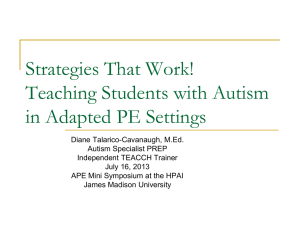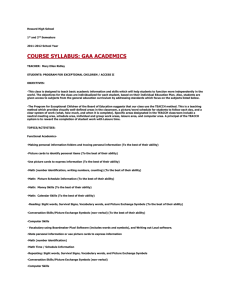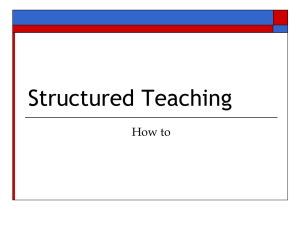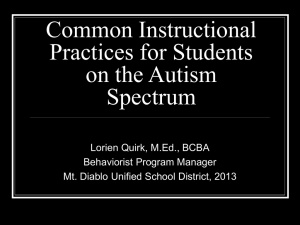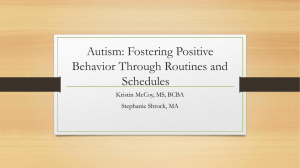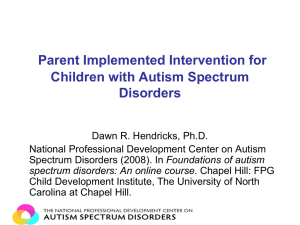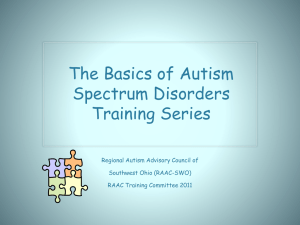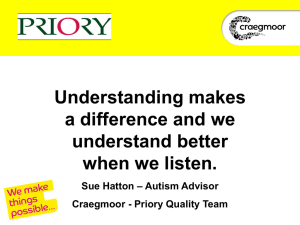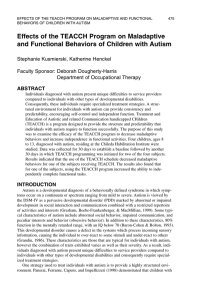TEACCH Strategies - Pre-K... the Right Beginning - Miami
advertisement
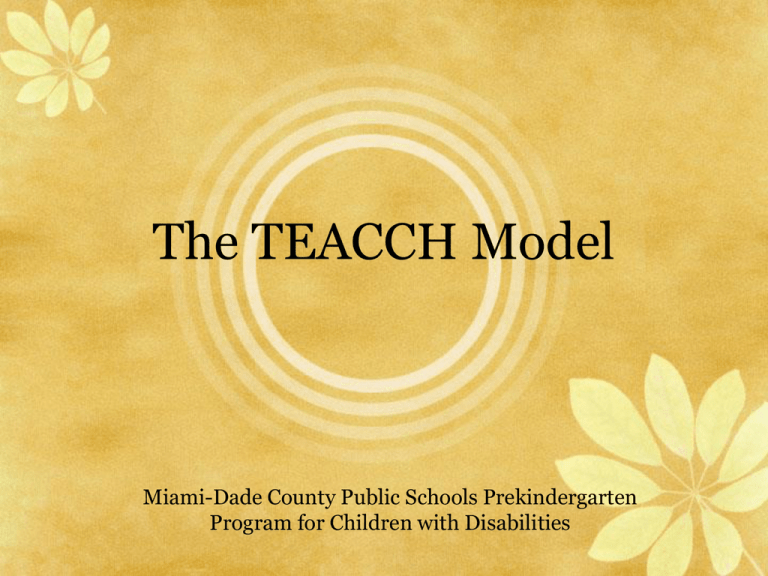
The TEACCH Model Miami-Dade County Public Schools Prekindergarten Program for Children with Disabilities The Prekindergarten program for children with disabilities from MiamiDade County Public Schools offers different models for Students with Autism Spectrum Disorders. Among all of these models, the Self-Contained classrooms apply strategies from the prestigious program TEACCH (Treatment and Education of Autistic and related Communication handicapped Children). TEACCH is a program located in North Carolina and it is an evidencebased service, training, and research program for individuals of all ages and skill levels with Autism Spectrum Disorder. The information about the Prekindergarten Program for Children with Autism is provided here in this website to show the different strategies that we implement and the model that we replicate in our classrooms. This program based the strategies on the TEACCH model, but we also adjust these strategies to our own students, their families, and the community in general. • This information has been taken from different books and articles from the TEACCH model • Tasks Galore-Making Groups Meaningful • Let’s Get Started-Visually Structured Tasks- Susan Boswell • Manuals from the level 1 and 2 training TEACCH Model. What is TEACCH? • TEACCH is an evidence-based service, training, and research program for individuals of all ages and skill levels with Autism Spectrum Disorder • TEACCH is a North Carolina program administered through the University of North Carolina at Chapel Hill, but because of its training activities and publications the TEACCH approach is widely known nationally and internationally. • Founded in the early 1970s by the late Eric Schopler, Ph.D., TEACCH developed the concept of the “Culture of Autism”as the way of thinking about the characteristic patterns of thinking and behavior seen in individuals with this diagnosis. “The Culture of Autism” involves: • Relative strength in and preference for processing visual information. • Frequent attention to details but difficulty understanding the meaning of how these details fit together. • Difficulty combining ideas. • Difficulty with organizing ideas, materials, and activities. • Difficulties with attention • Communication problems • Difficulty with concepts of time, including moving too quickly or too slowly and having problems recognizing the beginning, middle, or end of an activity. • Tendency to become attached to routines with the result that activities may be difficult to generalize from the original learning situation and disruptions in routines can be upsetting, confusing, or uncomfortable. • Very strong interests and impulses to engage in favored activities, with difficulties disengaging once engaged. • Marked sensory preferences and dislikes STRUCTURED TEACHING • TEACCH developed the intervention approach called “Structured Teaching.” • According to Division TEACCH, structured teaching helps people with Autism of all ages and levels of functioning by organizing their environments and providing clear, concrete and meaningful visual information • The principles of Structured Teaching include: 1. 2. Understanding the culture of Autism Developing an individualized person-and family-centered plan for each client or student, rather than using a standard curriculum. STRUCTURED TEACHING 3. Structuring the physical environment. 4. Using visual supports to make the sequence of daily activities predictable and understandable. 5. Using visuals supports to make individual tasks understandable. STRUCTURED TEACHING What are the reasons for using Structured Teaching? • Receptive Communication Helps them to understand situations and expectations. • Learning Support Teaches using stronger visual channel rather than auditory channel. • Independence Support device for independence and generalization. • Calming Reduces Overloading • Reduces behavior problems Often the result on confusion and anxiety. LEVELS OF STRUCTURE Visual Structure of Tasks Routines and Strategies Work System Individual Schedule Physical Structure 1. PHYSICAL STRUCTURE The environment should be set up and organized so that the child understands where different activities take place and where materials are kept. Key concepts to keep in mind when setting up clear physical structure include: • Establish clear visual and/or physical boundaries • Minimize visual and auditory distractions • Areas for all the activities. PHYSICAL STRUCTURE PHYSICAL STRUCTURE PHYSICAL STRUCTURE INDIVIDUAL VISUAL SCHEDULE • Individual visual schedules give students the sequence of their school activities. Students check their schedules and see cues that indicate to them, in an individualized way, that they are going to certain activity. Students might use an object, a line drawing, a written word, a photograph, or any type or cue that is meaningful to them. What the different cues have in common is that they provide a visual way for the student to know where to go and what activity to expect. (Task Galore Laurie Eckenrode, Pat Fennel, and Kathy Hearsey) INDIVIDUAL VISUAL SCHEDULE • A routine to teach flexibility • The student’s schedule visually tells him where am I supposed to be? And when will I get to do what? • It moves the student through the physical spaces we have createdcalmly, purposefully, and independently • It is a positive routine to help the student be flexible and deal with changes • We have to teach the meaning behind the visual not a routine • Symbol System Used • Objects (functional or representational) • Pictures or photos INDIVIDUAL VISUAL SCHEDULE • Written Words • A combination of these • How does the child manipulate it ? • Carry and use objects • Carry and match symbols • Reference symbols and mark off move when finished “We don’t fade schedules from our students since they are a tool for life-long independence. Rather, we design schedules to grow with the child.” INDIVIDUAL VISUAL SCHEDULE INDIVIDUAL VISUAL SCHEDULE INDIVIDUAL VISUAL SCHEDULE INDIVIDUAL VISUAL SCHEDULE INDIVIDUAL VISUAL SCHEDULE WORK SYSTEM • Organizational system that gives information to students about what they are to do when arriving to a classroom location • Builds independence, sequencing, and generalization across settings WORK SYSTEM • The work system is a key tool for sequencing, independence, and generalization. • Like the schedule, the work system is a powerful routine that brings an element of familiarity and predictability to different settings. • As a scheduled activity begins, it is a systematic, visual way to answer the following 4 questions: • How much am I to do? • What and in what order am I to do? • How will I know when I am finished? • What happens when I am finished? WORK SYSTEM • • The concept of finished is a key organizer and motivator for people with Autism. The work system emphasizes teaching the concept of first/then. Individualize work system by: 1. Types of work system – Left to right – Matching – Written WORK SYSTEM 2. How to manipulative the work system Move activities Match symbols to activities Read list of activities 3. How to indicate finished Put things into a finished location on the right Put things away Mark off list 4. How much movement is involved during session Stay seated throughout Move within small work area Move within larger area to get and replace materials as needed Independent Work System If you use baskets as a work system….. You can start with one basket at a time and build up until the child can complete three or more baskets independently. Independent Work System If you use baskets as a work system….. Materials in baskets MUST be tasks that the child can already do! This is not a time “to teach “ new tasks to the child. Independent Work System If you use baskets as a work system….. The materials in the baskets must have a beginning and an end. If the task is open-ended the child does not know what to do or what is expected. Independent Work System If you use baskets as a work system….. Do not allow the children to play with the basket work task toy/materials. Teach the children to take the materials out of the baskets. Complete the tasks. Put the baskets in the finished area, and check the transition picture to see where he is going next. Most of the materials used for the basket tasks are also located in some other area of the room. Allow the child to transition to that area as a reinforcer and play with the toys. INDEPENDENT WORK SYSTEM INDEPENDENT WORK SYSTEM WORK SYSTEM When the student arrives at any location, are the four questions answered? • At circle time? • In any play area? • In large group time? • In places out the classroom? WORK SYSTEM WORK SYSTEM WORK SYSTEM WORK SYSTEM Routine and Strategies • People with Autism like routines. They create their routines as a coping strategy to compensate for lack of understanding. • Checking the schedule and following the work system are two powerful routines that build independence and flexibility. • Other routines/strategies to teach include the spatial and sequencing organization of working from left-to-right and top-to-bottom. • Routines and strategies help compensate for poor organization, judgment, and problemsolving abilities. OTHER VISUAL STRUCTURE OF ACTIVITIES • Within any specific activity, we add visual structure to capitalize on the student’s visual learning style, minimize reliance on auditory processing, and build independence. • • • • • TYPES OF VISUAL STRUCTURE Visual instructions: How the beginning, sequence of steps, and ending point of an activity is indicated. Examples include: Materials may define the task Left-to-right sequence of materials Jigs: tell the student how much of what material to get organized as first step of task TYPES OF VISUAL STRUCTURE(CONT.) • Product sample: a model to show the finished produce • Visual Organization: How the space and materials are organized to enhance the student’s attention and independence. Examples include: • Self-contained tasks • Container organization • Stabilize the materials • Limit the space • Limit the amount of materials • Visual Clarity: How we draw the student’s attention to the most relevant and useful information. Examples include: • Color coding • Labeling • Highlighting • Exaggerating a concept VISUAL STRUCTURED ROUTINE VISUAL STRUCTURED ROUTINE
